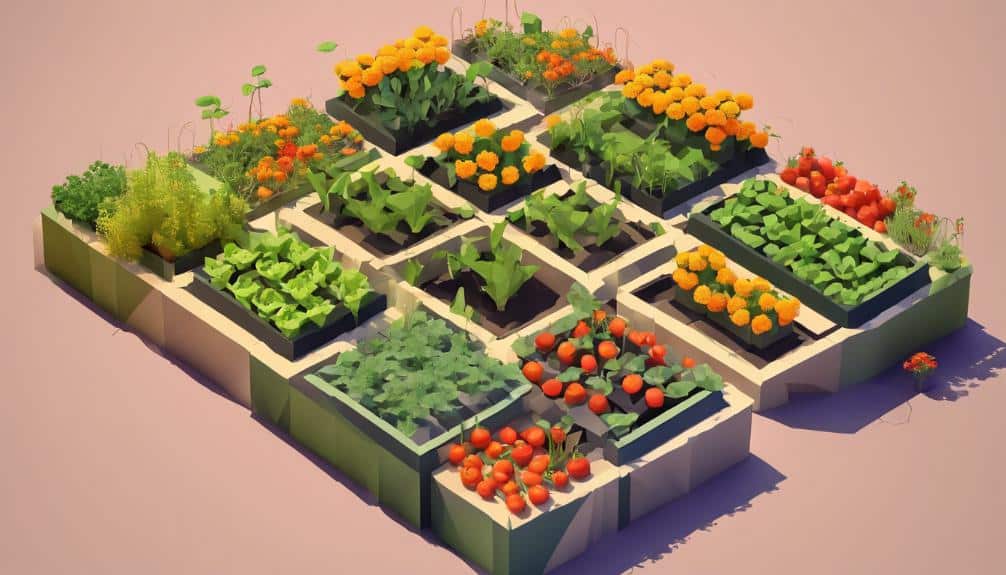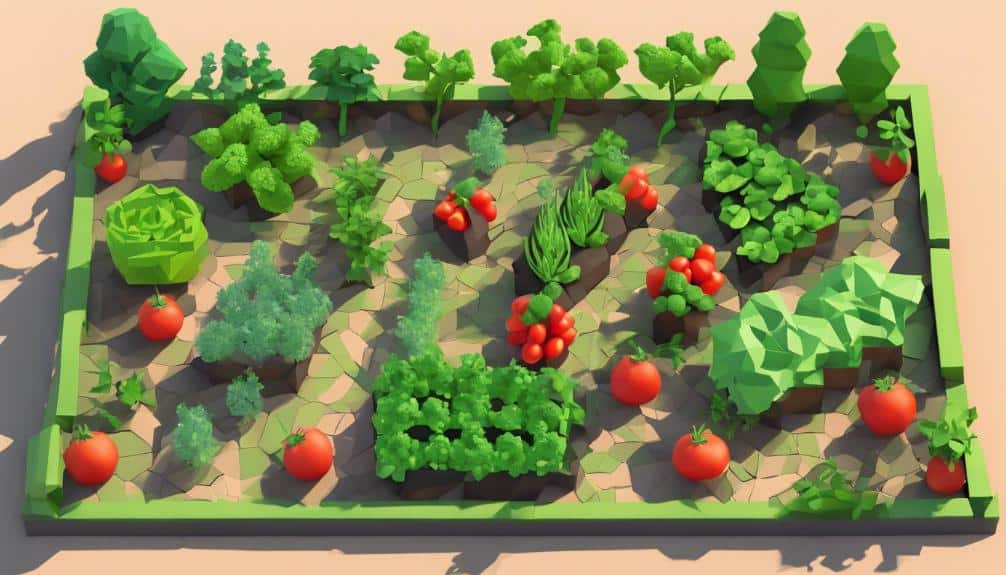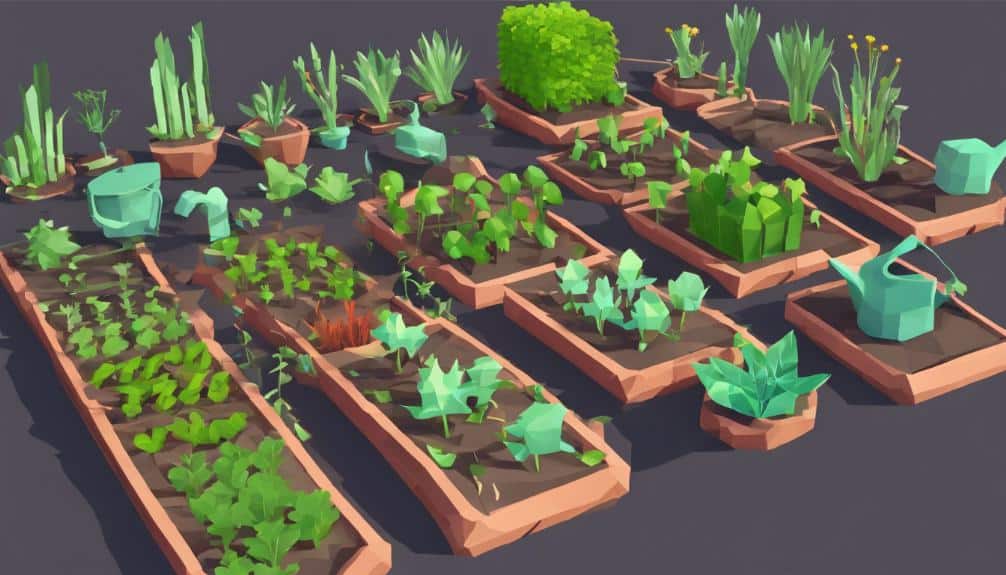Companion planting can help improve soil quality by promoting biodiversity and reducing the need for chemical fertilizers.
Some common examples of companion plants include pairing tomatoes with basil to enhance flavor and repel pests, or planting marigolds near vegetables to deter harmful insects.
Companion planting can also help with pollination and attracting beneficial insects to the garden.
By carefully selecting plant combinations, gardeners can create a more balanced ecosystem that supports healthy plant growth and reduces the risk of crop failure.
Read this guide wrote about growing celery plants from seeds. An easy way to add celery to your garden. And here is plant care guides for Elderberry and Possum Grapes.
What Is CompanionPlanting?
Companion planting pairs different plant species in vegetable gardens to promote mutual support and garden health. Plants release substances to repel pests and fix nitrogen for growth. Pairing marigolds with tomatoes deters nematodes.
Basil near peppers enhances flavor and repels insects. These pairings maximize space and soil health for a successful garden.
Benefits of Companion Planting
Companion planting offers you the opportunity to save space in your garden, improve soil health, and provide plants with mutual support.
By strategically selecting companion plants, you can maximize your garden’s potential while creating a harmonious ecosystem that benefits all vegetation.
This approach not only optimizes your garden’s productivity but also fosters a more sustainable and natural gardening environment.
Saving space
Vertical growth and strategic crop pairings in companion planting maximize garden space. Tall plants are planted alongside smaller ones to save space and ensure adequate sunlight and nutrients for each plant.
Interplanting compatible crops optimizes space and increases overall productivity. Different root structures work together to access and absorb essential minerals from the soil, efficiently utilizing soil nutrients.
Pairing plants with complementary growth habits and nutrient needs helps make the most out of limited gardening space, leading to a thriving vegetable garden.
Soil health
Companion planting diversifies plant roots and promotes nutrient absorption.
Different plant species increase soil biodiversity, aiding in aeration and nutrient access.
Legumes like peas and beans fix nitrogen, reducing the need for synthetic fertilizers.
Deep-rooted plants such as carrots and radishes break up soil compaction.
These practices maximize space, improve soil fertility, and create a thriving garden.
Mutual support
- Beans provide nitrogen to the soil, benefiting the growth of corn.
- The Three Sisters method combines corn, beans, and squash for mutual support.
- Some plant combinations offer physical support for growth.
- Companion planting creates a harmonious ecosystem for overall garden success.
Examples of the Best CompanionPlants
When planning your vegetable garden, selecting the right companion plants can greatly benefit your crops. By strategically pairing plants like tomatoes, peppers, green beans, cucumbers, onions, and lettuce, you can encourage growth and deter pests naturally.
These companion plants offer a variety of advantages, from repelling harmful insects to enhancing pollination, leading to a more robust and fruitful garden.
1. Tomatoes
Tomatoes benefit from planting with certain companion plants.
Basil repels thrips and attracts bees.
Marigolds deter nematodes and pests.
Carrots improve soil health.
Spinach helps repel aphids and attracts beneficial insects.
2. Peppers
Peppers benefit from companion planting with basil and tomatoes for growth and flavor. Avoid planting near beans as they can impede pepper growth.
Basil deters pests and attracts pollinators for better pollination. Tomatoes promote health in peppers.
3. Green Beans- Cucumbers
When companion planting cucumbers with beans:
- Beans support climbing cucumber vines.
- Corn provides shade for cucumber plants.
- Peas fix nitrogen in the soil.
- Avoid planting near sage for healthy development.
4. Onions
Onions are excellent companions for vegetables like carrots, cabbage, and tomatoes. They enhance growth and flavor. When planted with carrots, they deter carrot flies. Pairing with cabbage repels pests and boosts plant health.
Including onions in your garden creates a biodiverse environment. It helps with natural pest management and benefits neighboring plants. Consider adding onions to maximize growth and plant harmony.
5. Lettuce
- Lettuce can be companion planted with carrots, radishes, and strawberries in your vegetable garden layout.
- Planting lettuce alongside carrots can save space and help deter pests.
- Pairing lettuce with radishes benefits both plants in growth and flavor.
- Intercropping lettuce with strawberries creates an aesthetically pleasing and mutually beneficial garden bed.
- Combining lettuce with herbs like dill, chives, and cilantro enhances flavor and attracts beneficial insects for natural pest control.

6. Summer Squash/Zucchini
Summer squash and zucchini thrive when planted alongside nasturtiums, marigolds, beans, basil, and radishes.
Nasturtiums repel squash bugs and beetles, while marigolds deter harmful nematodes.
Beans help with nitrogen fixation for healthier growth.
Basil improves flavor and keeps away aphids and squash vine borers.
Radishes help fend off cucumber beetles and squash vine borers, ensuring a successful vegetable garden.
7. Carrots
Carrots grow well with companions like onions, leeks, and chives. These plants help keep carrot flies away and support the health of your garden.
Other good companion plants for carrots include tomatoes, which attract helpful insects like ladybugs. Nasturtiums repel pests and draw in pollinators, creating a more balanced garden.
Peas, radishes, and lettuce offer shade and help make the most of your garden space, which benefits the growth of carrots.
8. Radishes
Radishes have multiple benefits in companion planting:
- They repel pests like cucumber beetles and squash bugs when planted near cucumbers, squash, melons, and peas.
- Radishes deter carrot rust flies when grown alongside carrots.
- They enhance the growth of lettuce, spinach, and other leafy greens while keeping aphids at bay.
- When interplanted with cabbage and broccoli, radishes protect against cabbage worms.
- Their strong scent confuses and repels root maggots, making them great companions for potatoes and beets.
9. Sweet Corn
Sweet corn grows best when planted with beans, squash, sunflowers, basil, and dill.
- Beans help sweet corn by adding nitrogen to the soil.
- Squash acts as a natural mulch, keeping the soil moist and preventing weeds.
- Sunflowers attract pollinators and support tall corn plants.
- Basil and dill repel pests and attract helpful insects for pest control.
10. Potatoes
Potatoes grow well with cabbage, corn, beans, and peas in your garden. Marigolds help keep away pests like nematodes and beetles. Avoid planting potatoes near cucumbers and tomatoes, as they may compete for nutrients. Legumes like beans and peas add nitrogen to the soil, which is good for potatoes. Cabbage and corn improve soil structure and help manage pests.
Here’s a quick list of companion plants for potatoes:
- Cabbage: Improves soil structure, plant together.
- Corn: Helps with pests, interplant with potatoes.
- Marigolds: Deters nematodes & beetles, plant around the potato patch.
- Beans & Peas: Fix nitrogen in soil, rotate with potatoes for best results.
11. Peas
Peas benefit from specific companion plants for optimal growth:
- Carrots, Radishes, and Cucumbers: Their varied root depths and nutrient absorption support pea growth.
- Aromatic Herbs like Mint and Dill: Repel pests and attract pollinators.
- Nitrogen-Fixing Legumes such as Beans and Clover: Boost soil fertility.
- Marigolds: Planted nearby, they deter pests like nematodes and enhance pea yield.
12. Beets
Plant garlic, onions, and lettuce near your beets to deter pests and help them grow well. Beets benefit from being close to dill and mint for pest control and attracting helpful insects. Avoid planting beets near pole beans to prevent nutrient competition. Instead, consider radishes and spinach as companions for optimal growth.
Chamomile can also enhance beets’ development and soil health. Choose the right plant companions for thriving beets, leading to better pest management and higher yields in your vegetable garden.
Companion Planting with Herbs

Planting herbs with vegetables can have multiple benefits in the garden. For instance, basil planted near tomatoes not only enhances flavor but also deters aphids. Chives, when paired with carrots, can help deter carrot flies and promote the growth of the vegetables.
Parsley planted alongside asparagus can improve the growth and overall health of the asparagus plants. Planting dill and cilantro near vegetables can attract pollinators, leading to higher yields.
These companion planting strategies can create a more robust and balanced ecosystem in your garden, promoting healthy growth and reducing the need for chemical pesticides.
Flowers as Companion Plants
Flowers play an important role as companion plants in your vegetable garden. They attract essential pollinators like bees and butterflies, helping increase your garden’s productivity.
Certain flowers act as natural pest repellents, safeguarding your vegetables from harmful insects.
Beacon for Pollinators
- Marigolds, zinnias, and sunflowers attract bees and butterflies with their vibrant colors and abundant pollen.
- Lavender and borage provide essential nectar sources for sustaining pollinators.
- Sunflowers with their large blooms act as a visual guide, attracting pollinators to your garden.
- A diverse selection of flowers creates a colorful and enticing space for pollinators to thrive.
Deterrent for Pests
Marigolds, nasturtiums, and calendula are natural pest repellents in the garden. These flowers release scents that deter pests like nematodes, aphids, and whiteflies. Marigolds protect plant roots from root knot nematodes.
Nasturtiums attract predatory insects that eat garden pests. Calendula flowers repel pests and attract beneficial insects like ladybugs and hoverflies.
Use these flowers in your garden for a healthier growing environment.
How and When to Plant Companion Flowers
Plant marigolds, nasturtiums, and calendula to attract beneficial insects and repel pests.
Choose lavender, chamomile, and yarrow with strong scents to deter pests and attract pollinators.
Interplant flowers with vegetables for a visually appealing garden that supports plant health.
Use sunflowers and zinnias as natural supports for climbing vegetables like cucumbers and pole beans.
Companion planting for insect management
When planning your vegetable garden, understanding how companion planting can help manage insects is essential. Different plants can repel pests through their scents, attract beneficial predators, or even visually confuse insects.
Be mindful of these specific insect-plant relationships to naturally protect your crops from potential infestations.
Smells
Aromatic plants like marigolds and basil can mask the scents of your main crops, confusing pests and making it harder for them to locate their targets.
Certain companion plants release odors that repel harmful insects, reducing the need for chemical pesticides and promoting natural pest control.
Scents from plants like chives and dill can attract beneficial insects such as ladybugs and parasitic wasps, which prey on common garden pests.
Brightly colored flowers planted near susceptible crops can visually distract and deter pests from feeding on your vegetables.
Predators or parasitoids
Companion planting attracts predators or parasitoids to manage garden insects effectively. Marigolds lure beneficial insects like ladybugs and parasitic wasps.
Nasturtiums repel aphids with their strong scent. Chives control Japanese beetles by attracting predatory ground beetles.
Dill attracts hoverflies and lacewings, which eat aphids and mites. Basil helps repel mosquitoes and flies.
These companion plants create a balanced ecosystem and reduce pest issues in the garden.
Visually distraction
Boost your vegetable garden’s pest defenses with visually distracting companion plants. Use marigolds with vibrant flowers, tall sunflowers, and plants with different textures to confuse and deter insects.
Incorporate strong-scented plants to mask the odor of host plants. These natural methods help protect your crops.
Insect-plant relationships
Specific insect-plant relationships in your vegetable garden can manage pests and boost plant health naturally. Pairing certain plants strategically creates beneficial interactions. Here are examples:
- Marigolds manage nematodes and harmful insects.
- Chives deter carrot rust fly and aphids.
- Nasturtiums repel cucumber beetles and attract predatory insects.
- Basil controls aphids and attracts pollinators.
- Dill combats aphids and attracts ladybugs.
Watering Companion Plants

To help companion plants grow well, water deeply and infrequently. This encourages strong root growth and improves their ability to handle dry conditions. Follow these tips for healthy plants:
- Water deeply for plants with long taproots.
- Water slowly and deeply for plants with shallow root systems.
- Use drip irrigation to water directly at the roots and reduce water waste.
- Check soil moisture regularly to adjust watering based on plant needs and weather.
Which Vegetables Shouldnt Be Planted Together
Certain vegetables shouldn’t be planted together in a vegetable garden. For example, avoid planting potatoes and tomatoes close to each other because they’re both prone to blight and diseases.
Keep onions away from peas or beans as they’ve different soil nutrient requirements.
Also, don’t plant cucumbers with sage, as sage can hinder the growth of cucumbers.
Garlic and peas shouldn’t be planted together because garlic can stunt the growth of peas.
Companion GardeningTips
Plan your companion garden by considering plant height for adequate shading. Place tall plants strategically for shade.
Ensure proper spacing for growth and avoid resource competition. Optimize sun exposure for healthy plant development.
Use tailored watering techniques for each plant’s needs.
